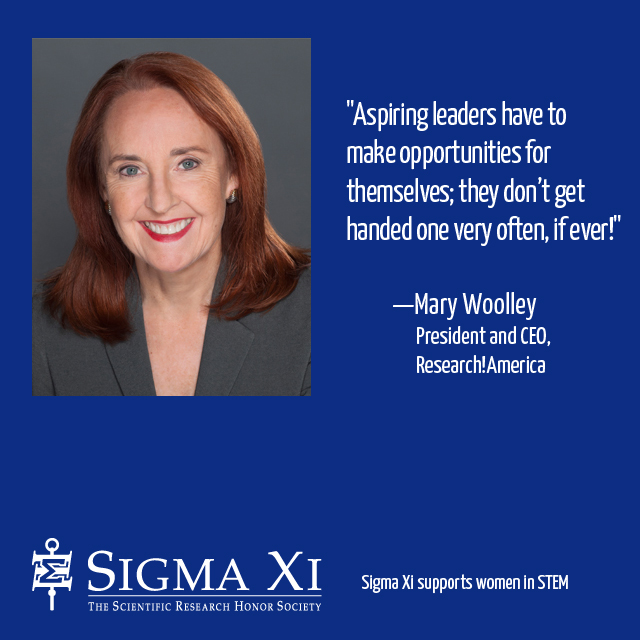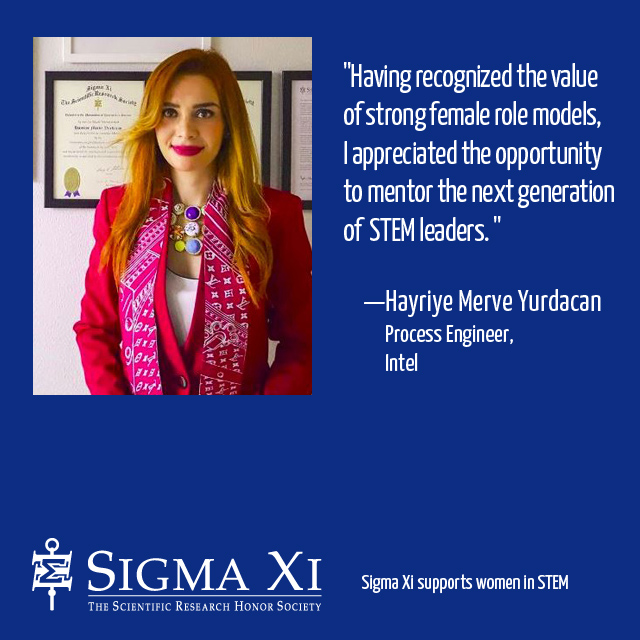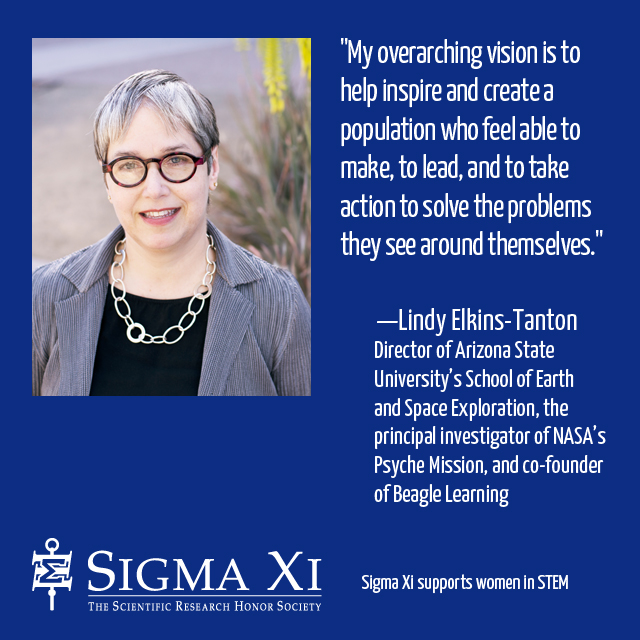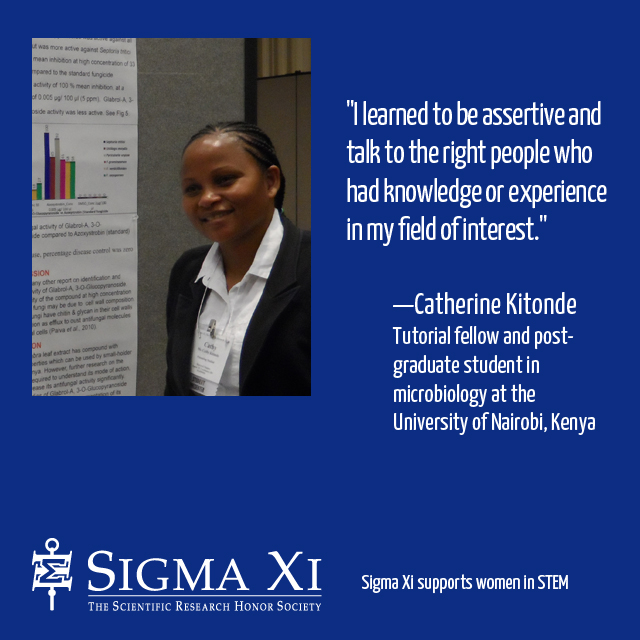Women in STEM: 2017
March is Women's History Month, a time to celebrate the contributions women have made to society. Sigma Xi will participate by celebrating women's contributions to science, technology, engineering, and math (STEM). We asked Sigma Xi members in STEM to share their career experiences and their advice for girls and women interested in STEM.
Mary Woolley

What is you current position?
President and CEO of Research!America.
How would you describe your job?
I work at the very exciting intersection where research and innovation meet the political and policy environment. We are an in-the-moment organization, so it’s a new challenge every day. Keeping a finger on the pulse of public sentiment toward science is a dynamic part of our work with which I am personally engaged—it’s absolutely essential in developing effective advocacy. In the broader picture, I am privileged to work with, for, and around some of the smartest, most accomplished and most highly regarded people in our nation. Career fulfillment doesn’t get any better than that!
As a nonprofit alliance of nearly 400 institutional and organizational members, Research!America works to help the medical and health research ecosystem—which very much includes the patient community—speak with one voice when making our case to policymakers, the media, and the public. It’s highly motivating to know that advocacy can continue to help speed the day when the hard work of research and innovation will pay off in new treatments, cures and preventions—finding solutions to what ails us as individuals, communities and as a nation.
It’s also motivating to find the many—and there are many—ways the overall science community can benefit from working together in advocacy. That’s an increasingly important part of our work, and I relish it thoroughly.
What is a challenge that you have had to overcome as a woman in STEM?
It’s often said that challenges are opportunities in disguise, and that describes many of the challenges I have faced! For example, it can be difficult to be the only woman in the room—including in the boardroom. Social science research confirms that having a single “token” of any group whether based on gender, race or ethnicity, age, or political ideology is not helpful to a board or its mission. And it can be isolating for that individual.
How did you overcome this challenge?
It’s important to speak up and provide fresh perspectives—to focus on making your presence an opportunity for that board to re-think its composition and to realize greater value going forward. Volunteering to serve on the nominating committee of a board of directors is a good way to help broaden the sights of a board that is perhaps “too male and too pale.”
It’s also a good plan for a woman stepping onto a board to get involved immediately in the finance work of the board. This step is often outside the expertise of a STEM-educated or experienced individual, whether they are male or female, so it can be an opportunity to learn that shouldn’t be overlooked. Aspiring leaders have to make opportunities for themselves; they don’t get handed one very often, if ever!
Hayriye Merve Yurdacan

What is you current position?
Process engineer at Intel and the Southwest Regional Representative on the Sigma Xi Committee on Nominations.
How would you describe your job?
I work as a process technology development engineer at Intel to create industry-leading semi-conductor technology. To accomplish this, I am a part of multi-disciplinary engineering team responsible for process and equipment development. My work includes process design, utilizing equipment for optimal manufacturing conditions and finally transferring these conditions to factories across Intel.
In addition, I have been working with University of Southern California on various research projects including mechanical, thermal, and optical properties of polymers and development of high performance nanocomposite membranes for water reclamation and nanofiltration. It is a highly interdisciplinary research that combines chemistry, chemical engineering, environmental engineering, and materials science.
What is a challenge that you have had to overcome as a woman in STEM?
Women in STEM face many challenges. I would describe STEM experience as a strong wind that constantly drags you into new adventures and challenges. The biggest challenge I have ever faced was in grad school when I was a team leader/head teaching assistant where I led and trained large groups of chemistry TAs for five years. Moreover, this group of TAs changed every semester, which meant I had to work with different groups of people from different cultures and backgrounds each time.
Being a female leader in STEM presented a new set of difficulties. First, it was hard to find a female mentor and role model in a STEM field who was in similar circumstances to those I faced. Second, there were times when I felt my voice was not heard. I had to work much harder to make sure my voice was heard in this male-dominated environment. There were times I felt like my authority and opinion were challenged by others while I was leading the team.
How did you overcome this challenge?
I recognized that while you cannot change the behavior of others, you can change how you respond to it. Once you succeed in being self-confident you become less dependent and sensitive to the environment, giving you a more objective view and allowing you to be more present in public.
Establishing good communication with my team was also another approach that improved our cohesiveness. I found that improved communication lessened our misunderstandings and improved our mutual respect. In addition, I became a mentor to both female and male undergraduate students. Having recognized the value of strong female role models, I appreciated the opportunity to mentor the next generation of STEM.
Lindy Elkins-Tanton

What is you current position?
Director of Arizona State University’s School of Earth and Space Exploration, the principal investigator of NASA’s Psyche Mission, and co-founder of Beagle Learning.
How would you describe your job?
My job at ASU is to make the jobs of all the faculty and staff easier, if I possibly can, and to find all the ways I can to support the goals and visions of students, faculty, and staff. My overarching vision is to help inspire and create a population who feel able to make, to lead, and to take action to solve the problems they see around themselves. After years of thought, I think that is the core need for humanity’s future. And it is reached through education.
What is a challenge that you have had to overcome as a woman in STEM?
There is a fairly pervasive attitude in science and engineering that the emotionality of a situation or one’s personal feelings are irrelevant, and possibly even damaging and distracting from the objective task at hand. From this springs the idea that skills like team building and leadership coaching are either unimportant or easily achieved through common sense. Team building and leadership, however, are critical skills that lead to inclusion and diversity. Without a culture that allows anyone with the skills needed to succeed, no number of hiring rubrics will solve the problem of a group without diversity. It’s the culture that allows for success.
How did you overcome this challenge?
I talk unembarrassedly about culture. Speak and write politely to each other. Invite quiet people to speak their opinions. Don’t tolerate personal attacks or temper tantrums. This kind of culture produces success. People are unafraid to bring up potentially critical issues in an engineering design, for example. People are willing to ask the naïve questions that often produce the most innovative, interdisciplinary science. And large funding agencies understand the importance of functioning teams. So it’s not weakness or irrelevancy—a positive culture directly supports both success and diversity in science and engineering.
Catherine Kitonde

What is you current position?
Tutorial fellow and a post-graduate student who is studying microbiology at the University of Nairobi, Kenya.
How would you describe your job?
As a tutorial fellow, I am involved in optimal delivery of lectures and practicals in the thematic group. I also conduct PhD research in microbiology. My research is focused on the use of natural pesticides (sprays) to manage pathogens causing diseases to our crops.
What is a challenge that you have had to overcome as a woman in STEM?
Lack of equipped laboratories is a big problem in some African high schools and universities. As a woman, I had interest in STEM but it was difficult to achieve set research goals or objectives due to lack of equipment to conduct sound research.
In addition, I came from a poor background so it was not easy to pursue STEM or take any other program in the university. Poverty leads to many difficulties when in school and may lead to poor performance (poor grades) if there is no support provided and you end up not succeeding in taking STEM programs.
Poverty in Africa, especially in Kenya, has made many girls drop out of school to work and earn small wages for their survival, while others go for early marriages whereby we end up having communities with uneducated women (the leaky pipe) and very few end up taking STEM programs. Even those who take STEM may not take high positions in higher education institutions or research institutions dominated by their counterparts.
Also in Africa, some think that science is made for boys. They think that mathematics is hard, physics is hard, and engineering is hard. It’s only that they never thought of the determination and passion for it and say, “I’m going for it.” I got into microbiology because I was very curious about how and why phenomena happen. I also wanted to make new discoveries.
How did you overcome this challenge?
A curious person is always asking questions and looking for answers. Through that, I came to find that I love research. I fight for what I like. Sometimes it was not easy to conduct research and attend tuition, but I found a mentor (Prof. Lucy Irungu). It is advisable to be proactive—when she mentored me I was responsible for taking the lead. That is why I am where I am today as a tutorial fellow and a PhD microbiology student at the University of Nairobi.
I am eager to finish my studies soon and start conducting meaningful research with a determination that I will lead a big team of researchers, just like professors do. Therefore, I feel that I am in the right place to conduct research in the university and learn to solve societal problems.
I did my PhD work at Dow AgroSciences, Indiana, USA. Before I went to Dow AgroSciences, I won an AWARD Fellowship, which stands for African Women in Agricultural Research and Development. AWARD is a career-development program that equips top women agricultural scientists across sub-Saharan Africa to accelerate agricultural gains by strengthening their research and leadership skills through tailored fellowships. It is a catalyst for innovations with high potential to contribute to the prosperity and well-being of African smallholder farmers, most of whom are women.
During my AWARD Fellowship at Dow AgroSciences, I learned that without equipped labs in Africa I can collaborate with developed labs to conduct quality research and help solve problems in the society. I would encourage universities and research institutions/companies from developed countries to collaborate with African universities and research institutions by increasing the number of scholarships, especially for bright girls and women from poor backgrounds, to increase the number of women in STEM who can take high positions and make sound decisions in higher education and research institution dominated by their counterparts.
More from the Women in STEM Project
2020
2019
2018
2017
2016
2015
All years